Hoarding disorder (HD) is a mental health condition in which a person experiences a compulsive urge to acquire and accumulate material possessions, along with difficulty in discarding excessive clutter.
What Is Hoarding Disorder?
Hoarding disorder (HD) is a mental disorder [mfn] Vilaverde, D., Gonçalves, J., & Morgado, P. (2017). Hoarding Disorder: A Case Report. Frontiers in psychiatry, 8, 112. https://doi.org/10.3389/fpsyt.2017.00112 [/mfn] characterized by the urge to save and acquire new items, difficulty discarding current possessions, and excessive household clutter. It is popularly considered a subtype of obsessive-compulsive disorder and is also known as compulsive hoarding disorder. However, experts contend that it should be regarded as a separate disorder with its own unique set of symptoms.
People with this condition display cognitive distortions related to hoarding along with behavior that is often disruptive to their daily life. They are in a constant cycle of acquiring things (regardless of actual value or use) and piling them in living areas; such an enduring behavior pattern can compromise their general hygiene and well-being as well as that of the people around them.
If we take a closer look into the psychology of hoarding, it appears that people with this disorder are likely to derive most of their self-worth from material possessions.
The last two decades have seen a steady rise in the number of hoarding disorder cases. Research affirms that 2–14% [mfn] Davidson, E. J., Dozier, M. E., Pittman, J. O. E., Mayes, T. L., Blanco, B. H., Gault, J. D., Schwarz, L. J., & Ayers, C. R. (2019). Recent Advances in Research on Hoarding. Current psychiatry reports, 21(9), 91. https://doi.org/10.1007/s11920-019-1078-0 [/mfn] of the global population suffers from symptoms of compulsive hoarding.
The overall prevalence [mfn] Jaisoorya, T. S., Thamby, A., Manoj, L., Kumar, G. S., Gokul, G. R., Narayanaswamy, J. C., Arumugham, S. S., Thennarassu, K., & Reddy, Y. C. J. (2021). Prevalence of hoarding disorder among primary care patients. Revista brasileira de psiquiatria (Sao Paulo, Brazil : 1999), 43(2), 168–173. https://doi.org/10.1590/1516-4446-2020-0846 [/mfn] of this disorder is higher in men (than women) [mfn] Vilaverde, D., Gonçalves, J., & Morgado, P. (2017). Hoarding Disorder: A Case Report. Frontiers in psychiatry, 8, 112. https://doi.org/10.3389/fpsyt.2017.00112 [/mfn], the elderly population, and people with certain psychiatric disorders (like obsessive-compulsive disorder, stress disorders, etc.). However, the personal nature of hoarding and the stigma attached to mental healthcare treatment prevents people from seeking medical attention.
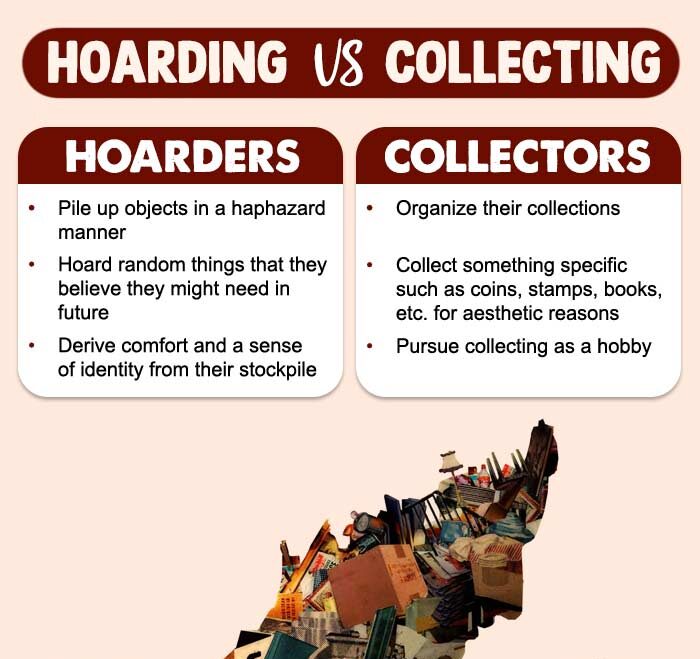
Case Example
Mr. Shetty (a 60-year-old man) was in the habit of storing unnecessary things such as newspapers and magazines dating back years, empty containers of toiletries, and old worn-out clothes and accessories.
Although his hoard had become more visible over the years, it seemed that he had been “collecting” things for decades. His garage was overflowing with spare parts of cars he didn’t have anymore and cartons full of numerous cords, defunct phones, old gadgets, and a bunch of other unusable items.
He got quite upset when his son or daughter cleared up his stuff. Sometimes, this would trigger him to hoard more things in rebellion. He seemed to derive a sense of comfort from all of his objects; “These are marks of my existence,” he would say. “They are proof that I have lived a worthy life.” He certainly did not believe that he may have a problem.
Mr. Shetty’s hoarding behavior had begun a few months after the death of his father, about 25 years ago. Since then, he was obsessed with holding on to material possessions, afraid that there would be nothing to show for him when he left the world.
Case Analysis
It is evident from the excerpt above that Mr. Shetty was experiencing difficulty in parting with his possessions and had been accumulating excess things that would clutter his living area.
These symptoms present a classic case of hoarding disorder with a lack of insight. Mr. Shetty’s sense of identity was indubitably linked to everything he had ever owned.
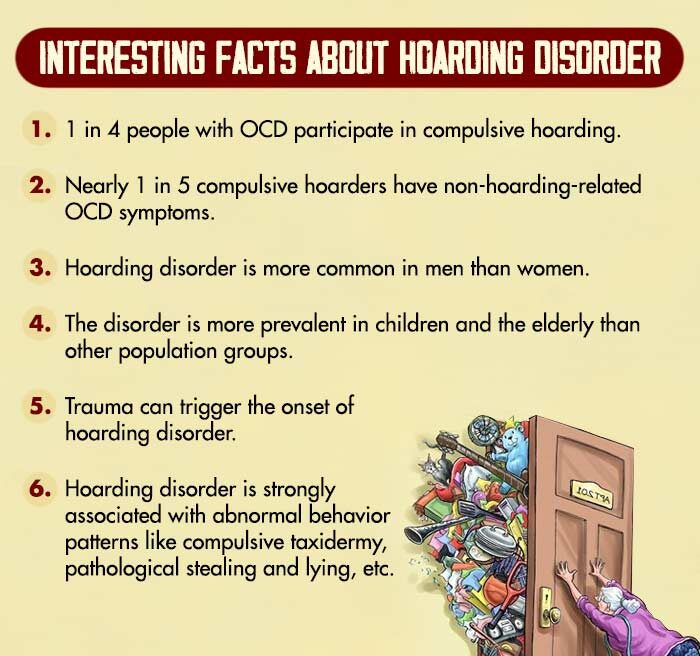
Symptoms Of Hoarding Disorder
The main hoarding disorder symptoms [mfn] Administration, S. A. and M. H. S. (2016, June 1). Table 3.29, DSM-5 Hoarding Disorder. Www.ncbi.nlm.nih.gov. Available from: https://www.ncbi.nlm.nih.gov/books/NBK519704/table/ch3.t29/ [/mfn] are:
- Persistent difficulty in discarding or parting with possessions.
- Significant distress associated with discarding objects.
- Accumulation of possessions that congest and clutter living areas.
Additionally, it may be noticed that the living area of the hoarder is barely available for use and is only ever cleared by the intervention of another person.
Types of Hoarding Disorder
As per research [mfn] Frost, R. O., Patronek, G., & Rosenfield, E. (2011). Comparison of object and animal hoarding. Depression and anxiety, 28(10), 885–891. https://doi.org/10.1002/da.20826 [/mfn], hoarding disorders can be categorized into the following types:
1. Trash hoarding
Trash hoarding is the hoarding of things that no longer have any use or value or are broken beyond repair. Items that trash hoarders usually collect include old electronics, old magazines, plastic containers, empty cans, glass containers, etc.
2. Food hoarding
Food hoarders hoard edible items and clutter living areas. They collect “extra” food in anticipation of an emergency or a natural calamity.
3. Compulsive shopping and hoarding
People with this type of hoarding disorder shop without discretion and often spend beyond their stipulated budget. Compulsive shopping (clinically referred to as compulsive buying disorder [CBD]) combined with hoarding disorder is considered a serious psychiatric disorder.
4. Animal hoarding
People with this tendency hoard animals, most frequently dogs or cats. They often refuse to give up animals who are sick, dying, or even already dead. Attempts by authorities to remove animals can result in immense distress.
5. Sentimental hoarding
Sentimental hoarders have a longing for the past and refuse to give up items related to memorable life events. This includes not wanting to get rid of things that may remind them of loved ones or holding on to things that are mementos from specific places or adventures.
Causes Of Hoarding Disorder
Research [mfn] Dozier, M. E., & Ayers, C. R. (2017). The Etiology of Hoarding Disorder: A Review. Psychopathology, 50(5), 291–296. https://doi.org/10.1159/000479235 [/mfn] attributes the development of hoarding to a combination of genetic factors, a reinforcement of beliefs surrounding reasons to save objects or vulnerability towards avoidant behaviors.
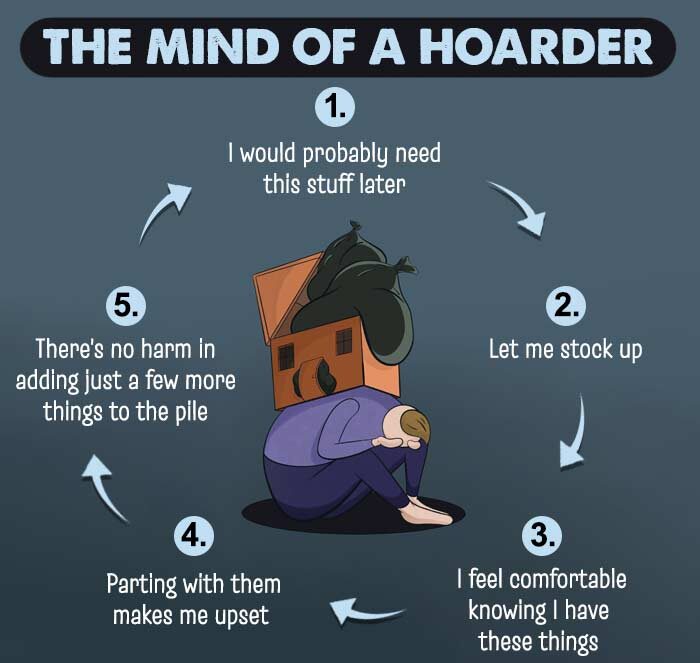
The common causes of hoarding disorder include:
1. Genetics
Twin studies suggest that up to 50% of the variance in hoarding behaviors may be genetically linked. It was also found that older adults with HD reportedly have an average of 2 biological relatives with symptoms or signs of hoarding disorder.
Read More About Genetics Here
2. Neurocognition
Premature cognitive aging and executive dysfunction, among other cognitive domains are linked to the risk of hoarding disorder.
3. Personality traits
People with certain personality traits related to perfectionism, indecision, and procrastination are more vulnerable to compulsive hoarding. Research also associates this disorder with several personality traits, namely:
- Paranoid
- Schizotypal
- Avoidant
- Obsessive-compulsive, etc.
Read More About Paranoid Here
4. Trauma
People with a history of trauma or those who have endured a stressful life event (positive or negative) are prone to hoarding disorder.
5. Cultural beliefs
Hoarding disorder can also result from certain beliefs about material possessions that are transmitted across generations in certain cultures.
Mental Health Effects of Hoarding
People with hoarding disorder may have several associated problems as a result of it. They are at a higher risk of developing
- Severe depression
- Obsessive-compulsive disorder
- Schizophrenia and other psychotic conditions
- Anxiety, etc.
They are also more likely to live alone and have significant issues in their inter-personal relationships due to their behavior.
Read More About Schizophrenia Here
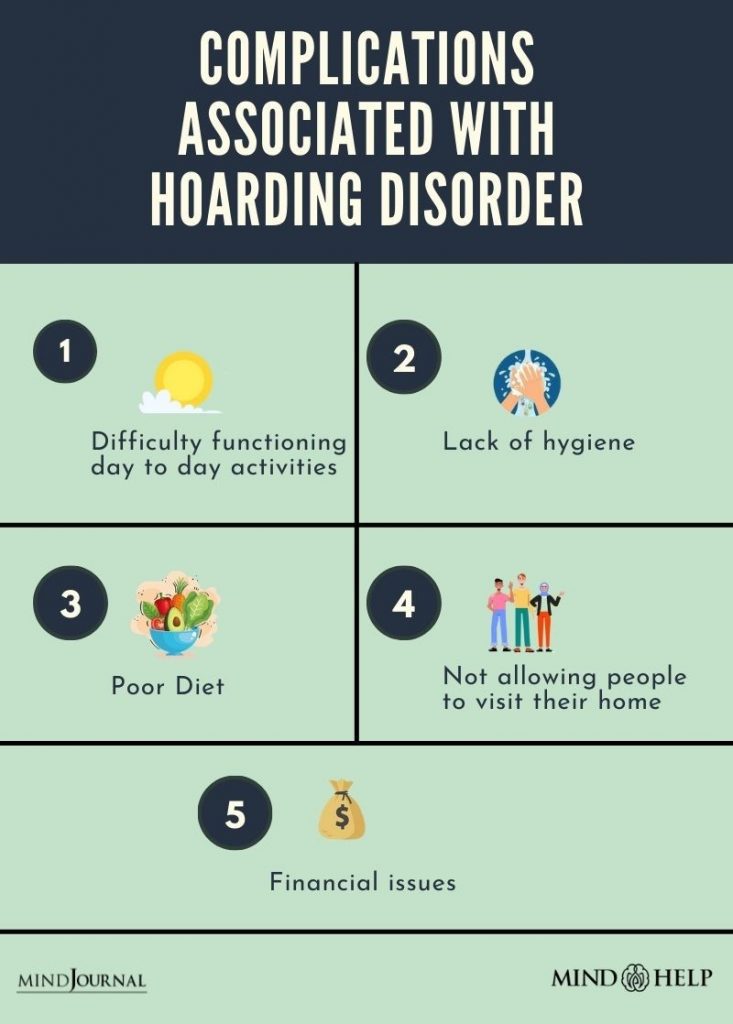
Diagnosis Of Hoarding Disorder
Hoarding disorder (HD) is classified as a mental disorder in the obsessive-compulsive spectrum [mfn] Mataix-Cols, D., Frost, R. O., Pertusa, A., Clark, L. A., Saxena, S., Leckman, J. F., Stein, D. J., Matsunaga, H., & Wilhelm, S. (2010). Hoarding disorder: a new diagnosis for DSM-V?. Depression and anxiety, 27(6), 556–572. https://doi.org/10.1002/da.20693 [/mfn] in the Diagnostic and Statistical Manual of Mental Disorders (DSM-5). It has been widely recognized as an independent condition that mandates help.
Mental health professionals (MHPs) usually take a detailed history of the symptoms to make an informed diagnosis and ensure that the symptoms are not caused by any similar conditions. They may also conduct certain assessments to guide the course of treatment.
Treatment For Hoarding Disorder
Hoarding disorder treatment [mfn] Mathews C. A. (2014). Hoarding disorder: more than just a problem of too much stuff. The Journal of clinical psychiatry, 75(8), 893–894. https://doi.org/10.4088/JCP.14ac09325 [/mfn] usually entails:
1. Medication
Several medications [mfn] Nakao, T., & Kanba, S. (2019). Pathophysiology and treatment of hoarding disorder. Psychiatry and clinical neurosciences, 73(7), 370–375. https://doi.org/10.1111/pcn.12853 [/mfn] are administered for dealing with hoarding disorder. These include:
- Selective serotonin reuptake inhibitors (SSRIs)
- Serotonin-norepinephrine reuptake inhibitors (SNRIs)
- Stimulants, etc.
Read More About Antidepressants Here
2. Psychotherapy
Cognitive-behavioral therapy (CBT) is most commonly used in the treatment of hoarding disorder. Motivational interviewing and harm reduction strategies address cognitive distortions related to the fear of discarding and the urge to accumulate items. CBT also seeks to induce behavioral changes such as sorting through and discarding materials systematically—either during therapy sessions or at home.
Read More About CBT Here
How To Overcome Hoarding Disorder
The first step to overcoming hoarding disorder is to accept the need for change and be open to receiving help.
You may consider the following self-help tips for coping with hoarding disorder:
- Set reminders to declutter your space every few days.
- Reach out to others and accept assistance in organizing your home.
- Communicate openly with your friends and family. Try participating in support groups that address hoarding disorder.
- Start small. Try discarding some of the things that you haven’t used in the past two to three years.
- Make a list of the things you think are indispensable and note down the cons of not having them. Ask yourself how your life would be different if those items were not there – would it hamper your daily activities?
- Do not hesitate to seek professional help for hoarding disorder if you find it difficult to manage the condition on your own.
- Focus on your personal goals and remember that your self-worth is not dependent on the items you possess.
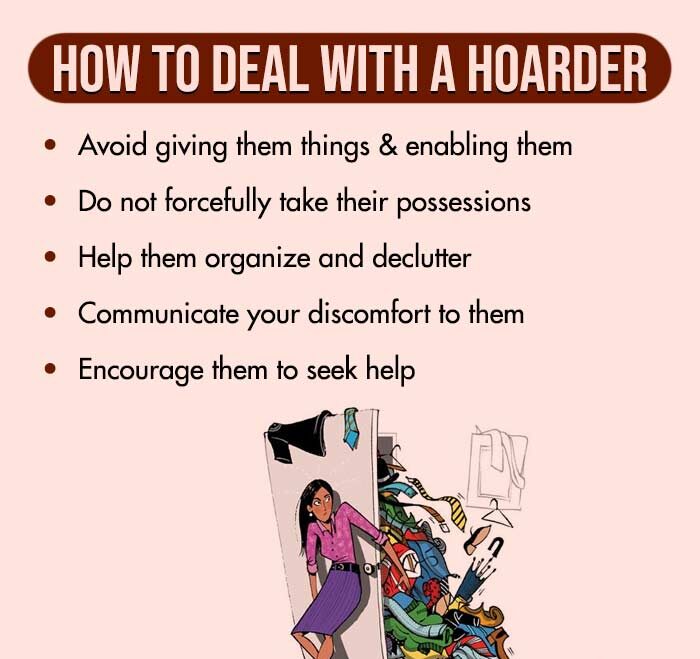
Takeaway
Hoarding disorder has been recognized and diagnosed as a debilitating mental disorder that negatively impacts our health, normal functioning, professional lives, and social relationships. Therefore, timely and proper treatment is essential to avoid its harmful consequences.
At A Glance
- Hoarding disorder (HD) is a mental health condition in which a person experiences a compulsive urge to acquire and accumulate items.
- The sufferer also experiences difficulty in discarding the excessive clutter.
- If left untreated, hoarding disorder can negatively impact a person’s personal and professional lives and social relationships.
- Hoarding disorder can be quickly addressed with psychotherapy, pharmacotherapy, and self-help coping strategies.
Frequently Asked Questions (FAQs)
1. What is the difference between hoarding disorder and obsessive-compulsive disorder?
A person suffering from obsessive-compulsive disorder (OCD) experiences frequent and persistent thoughts, urges, or images about some object or situation. Hoarding disorder, on the other hand, is the compulsive acquisition of items and the difficulty in letting go of them. Although hoarding disorder is historically considered a subtype of OCD, it is a separate clinical condition.
2. Who are some fictional characters with hoarding disorder?
Ariel from Disney’s “Little Mermaid” and the protagonists in films like Unstrung Heroes (1995), Girl with Black Balloons (2010), and Clutter (2013) are some fictional characters with hoarding disorder.
3. What do obsessive-compulsive disorder, body dysmorphic disorder, and hoarding disorder have in common?
Obsessive-compulsive disorder, body dysmorphic disorder, and hoarding disorder—all three mental health disorders are characterized by repetitive and uncontrollable thoughts and urges to engage in a particular behavior or situation.
4. How can we help someone with a hoarding disorder?
Empathize and use respectful language to communicate your concerns. Don’t focus on a total clean-up; instead, try to be supportive. Help them navigate through decluttering and therapy with kindness and understanding.

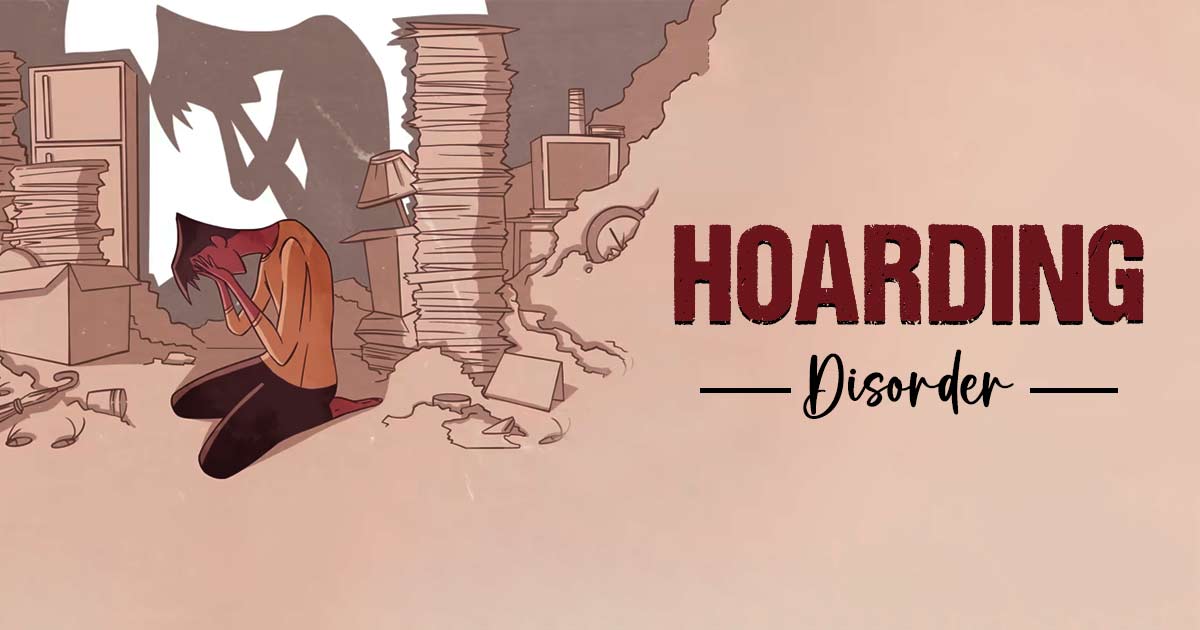

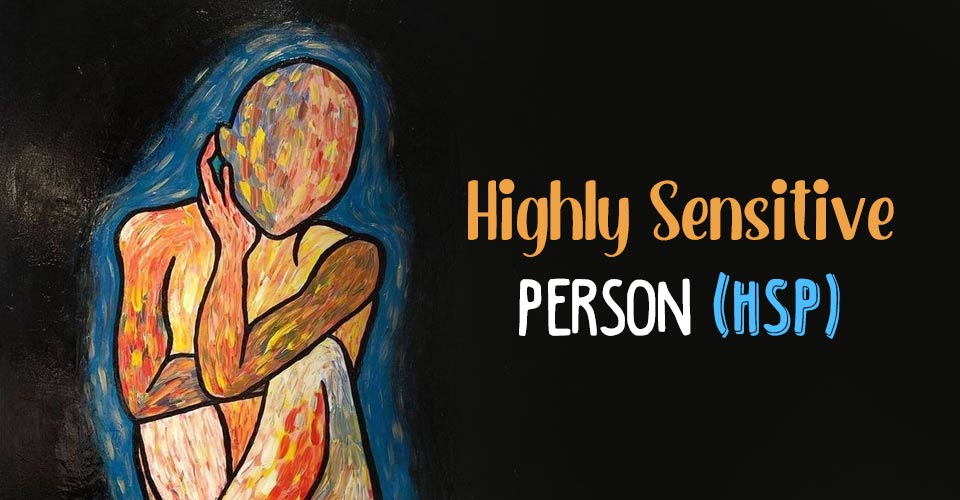
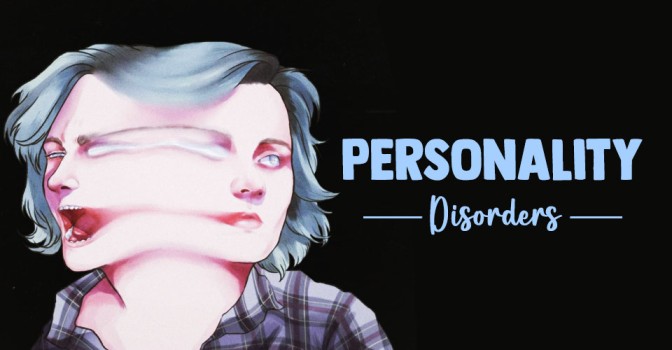
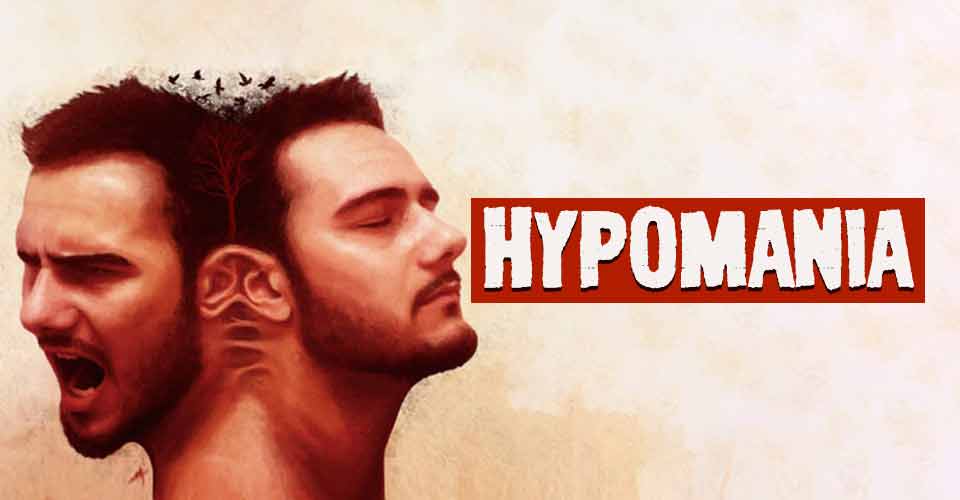
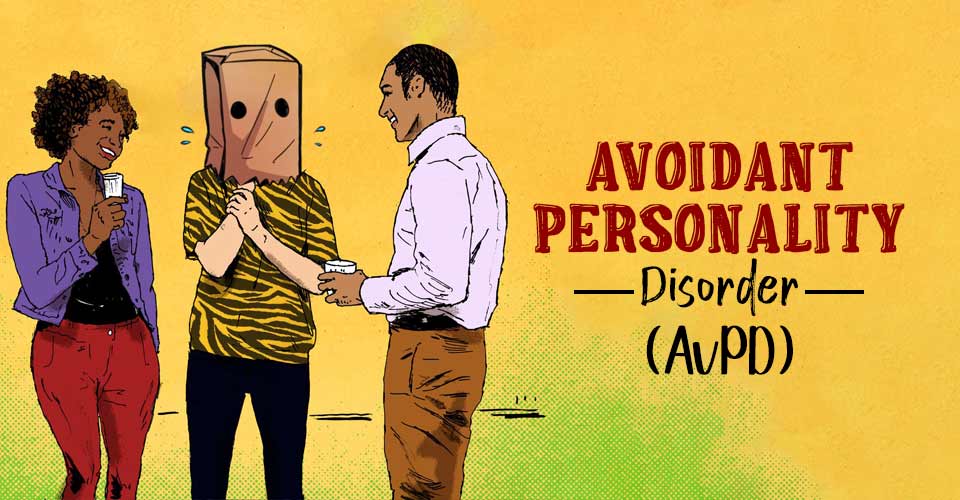

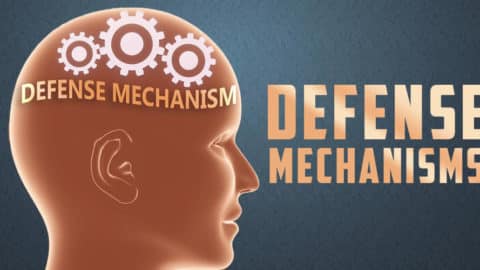
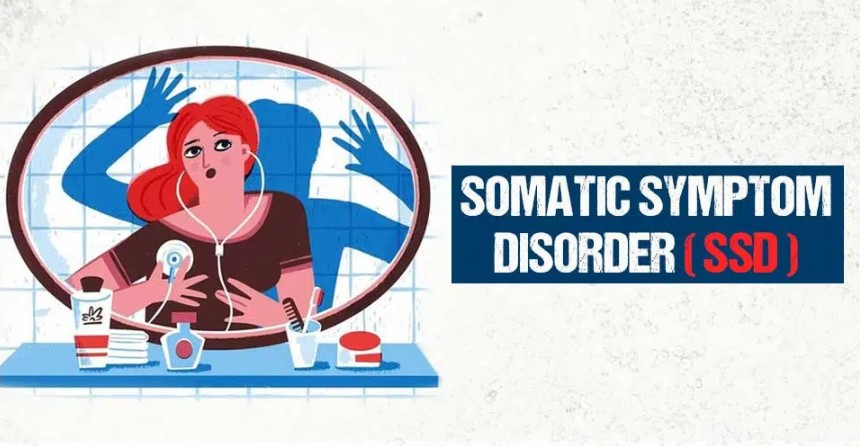

Leave a Reply